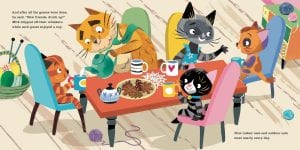If you’re writing fiction, you don’t have to worry about facts, right? Not necessarily. For some strange reason, if an author doesn’t create and maintain a smooth interface between make believe and real facts, a reader may say, Wait, that can’t happen! even about a story where, truly, none of it could happen! So authors sometimes revise to avoid details that might, as we say, “take the reader out of the story.”
 I’ll give you an example. My latest picture book, Winter Cats, is a fictional tale about an indoor cat who ignores his parents’ prejudices about outdoor cats and ventures out to make friends at their winter carnival. Willy, his parents, and the other cats talk, think, and engage in human behavior. I had loads of fun imagining outdoor cat activities such as twirling down icicles, building snow cats with acorn eyes, sledding on bark, and making snow angel cats. Clearly, Winter Cats is an anthropomorphic, imaginary tale. Willy invites his new friends home to play, and later they sit down for cookies and hot chocolate:
I’ll give you an example. My latest picture book, Winter Cats, is a fictional tale about an indoor cat who ignores his parents’ prejudices about outdoor cats and ventures out to make friends at their winter carnival. Willy, his parents, and the other cats talk, think, and engage in human behavior. I had loads of fun imagining outdoor cat activities such as twirling down icicles, building snow cats with acorn eyes, sledding on bark, and making snow angel cats. Clearly, Winter Cats is an anthropomorphic, imaginary tale. Willy invites his new friends home to play, and later they sit down for cookies and hot chocolate:
And after all the games were done,
he said, “New friends, drink up!”
Chocolate clung to whiskers
while each guest enjoyed a cup.
One of my critique group colleagues had an objection to the above lines when I read an early draft of this project. She noted that cats are not supposed to eat chocolate! My initial reaction was to laugh; really, you think this is an issue in this totally fictional world? But we proceeded to discuss whether this minor point would take readers “out of the story.” I didn’t think so, since kids often drink hot chocolate after outdoor winter fun, and I believed these lines would afford comfort and familiarity to readers. I left the text unchanged when the story was submitted to publishers.
Several months later, after the book had been acquired for publication by Albert Whitman, I received revision requests. Guess what lines got this comment from my editor?
When I took this to acquisitions, someone pointed out that it could be dangerous to have cats drinking chocolate. (Obviously, we’re already bending reality quite a bit here but…) Perhaps we could change this to “warm milk” instead?
Well, I finally gave in. While I didn’t really think anyone would give their cat hot chocolate after reading Winter Cats, what I didn’t want was for anyone reading my book to be thinking about that possibility at my story’s end instead of the value of diverse friendships.
It took a bit of fiddling to change these lines and still have my rhyme scheme work. The word “warm” just wouldn’t fit properly. So I simplified, and Ela Smietanka’s accompanying final illustration shows the cats sharing milk poured from a teapot into mugs.
And after all the games were done,
he said, “New friends, drink up!”
Milk dripped off their whiskers
while each guest enjoyed a cup.

As an author, maybe I can’t make everybody happy with the details in my make-believe worlds, but I will try. I don’t want to take any reader out of my story. I want them enchanted and engaged, from first to last word. Which is why Willy and his new friends drink milk instead of hot chocolate on a cold winter’s day!
Award-winning author Janet Lawler is the author of more than twenty-five fiction and nonfiction picture books for children. Winter Cats was published by Albert Whitman on 9/1/19.

2 thoughts on “It Is Fiction, Right?!”
Perfect! Excellent post explaining one of the many choices a writer has to make. I do love that the kitties drink milk, as we all know they do. But I wouldn’t have minded the hot cocoa connection either. Though, young readers are literal. They might just go home and make hot chocolate for their cats! I so enjoy Winter Cats each time I read it. Thank you for sharing your creativity!
Sorry for the delay(glitch on my site) in thanking you for these thoughts . But funny that I am finally seeing your comment while it is spring snowing here in CT!